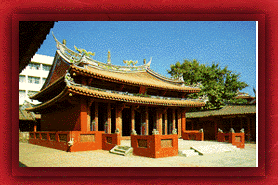

Address/2 Nan-men Road, Central District, Tainan City
Construction Date/1665.This temple was founded in 1665 during the period when Taiwan was under the administration of the Cheng family; it was first built by Cheng Ching at the suggestion of Ch'en Yung-hua.
Cheng Ching himself supervised the work.
In 1715 the temple was renovated; it was referred to as 'the first school house in Taiwan,'and was the earliest Confucius temple in the island.
In its first phase the temple existed simply as a free-standing offering-hall (the Hall of the Sage, the main structure containing the ceremonial tablet to Confucius).
It was not until 1715 that the Eastern and Western corridors were added. Other structures added at that time include the Shrine of Worshipping the Sage, situated to wards the back of the complex, the Ling-hsing Gate located in front of the Hall of Offering, the two Li-men Gates(Gates of Rites) located to the left and right side of the front gate, the Way of Righteousness, the Pavilion of the Sage reserved for the use of students, the Palace of Higher Learning (a pavilion), and other characteristic structures.
The foyer to the east of the Ling-hsing Gate was divided into two chambers, known respectively as the Shrine of the Great Officials and the Shrine of Local Worthies; on the west side, the corresponding rooms are the Shrine Dedicated to Filial Sons and the Shrine to Chastity and Obedience.
To the south of the Gate of Rites and the Way of Righteousness originally lay the Pool of Higher Learning and the Palace Wall; these structures were torn down during the Japanese occupation period. Outside the Eastern Corridor lie the Hall of Edification, the Hall of Literary Cultivation, and the Shrine Dedicated to Chu Hsi, the latter honoring the Southern Sung dynasty Neo-Confucianist whose interpretation of the Classics became orthodoxy during the Ming and Ch'ing dynasties. This shrine was also torn down during the Japanese occupation period.
From 1715 down to the present, this temple underwent a total of seventeen renovations; but the basic layout remains much as it was during the Ch'ing dynasty.